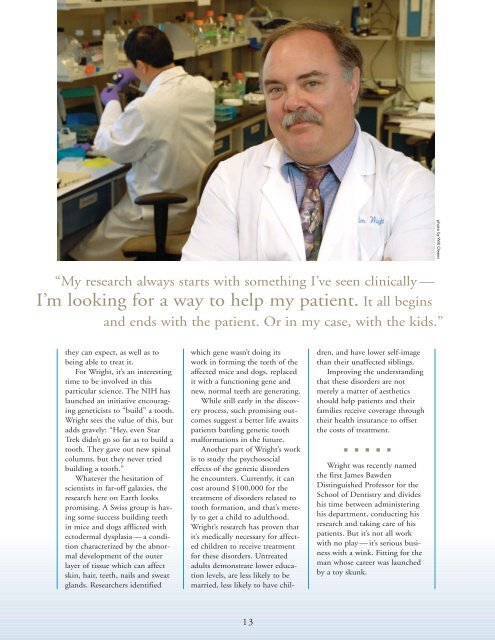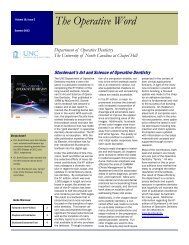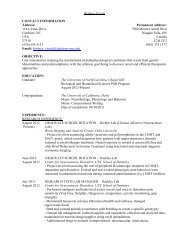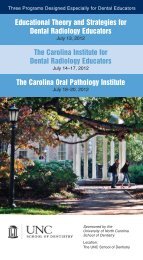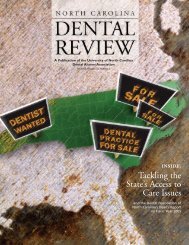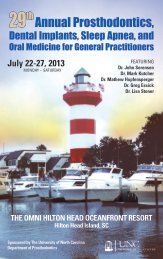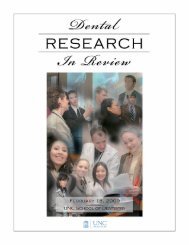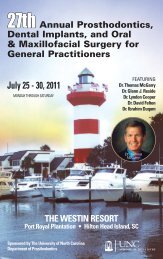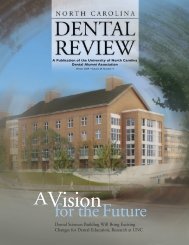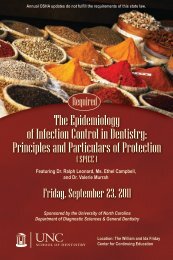Spring 2007 - UNC School of Dentistry - The University of North ...
Spring 2007 - UNC School of Dentistry - The University of North ...
Spring 2007 - UNC School of Dentistry - The University of North ...
You also want an ePaper? Increase the reach of your titles
YUMPU automatically turns print PDFs into web optimized ePapers that Google loves.
photo by Will Owens<br />
“My research always starts with something I’ve seen clinically —<br />
I’m looking for a way to help my patient. It all begins<br />
and ends with the patient. Or in my case, with the kids.”<br />
they can expect, as well as to<br />
being able to treat it.<br />
For Wright, it’s an interesting<br />
time to be involved in this<br />
particular science. <strong>The</strong> NIH has<br />
launched an initiative encouraging<br />
geneticists to “build” a tooth.<br />
Wright sees the value <strong>of</strong> this, but<br />
adds gravely: “Hey, even Star<br />
Trek didn’t go so far as to build a<br />
tooth. <strong>The</strong>y gave out new spinal<br />
columns, but they never tried<br />
building a tooth.”<br />
Whatever the hesitation <strong>of</strong><br />
scientists in far-<strong>of</strong>f galaxies, the<br />
research here on Earth looks<br />
promising. A Swiss group is having<br />
some success building teeth<br />
in mice and dogs afflicted with<br />
ectodermal dysplasia — a condition<br />
characterized by the abnormal<br />
development <strong>of</strong> the outer<br />
layer <strong>of</strong> tissue which can affect<br />
skin, hair, teeth, nails and sweat<br />
glands. Researchers identified<br />
which gene wasn’t doing its<br />
work in forming the teeth <strong>of</strong> the<br />
affected mice and dogs, replaced<br />
it with a functioning gene and<br />
new, normal teeth are generating.<br />
While still early in the discovery<br />
process, such promising outcomes<br />
suggest a better life awaits<br />
patients battling genetic tooth<br />
malformations in the future.<br />
Another part <strong>of</strong> Wright’s work<br />
is to study the psychosocial<br />
effects <strong>of</strong> the genetic disorders<br />
he encounters. Currently, it can<br />
cost around $100,000 for the<br />
treatment <strong>of</strong> disorders related to<br />
tooth formation, and that’s merely<br />
to get a child to adulthood.<br />
Wright’s research has proven that<br />
it’s medically necessary for affected<br />
children to receive treatment<br />
for these disorders. Untreated<br />
adults demonstrate lower education<br />
levels, are less likely to be<br />
married, less likely to have children,<br />
and have lower self-image<br />
than their unaffected siblings.<br />
Improving the understanding<br />
that these disorders are not<br />
merely a matter <strong>of</strong> aesthetics<br />
should help patients and their<br />
families receive coverage through<br />
their health insurance to <strong>of</strong>fset<br />
the costs <strong>of</strong> treatment.<br />
■ ■ ■ ■ ■<br />
Wright was recently named<br />
the first James Bawden<br />
Distinguished Pr<strong>of</strong>essor for the<br />
<strong>School</strong> <strong>of</strong> <strong>Dentistry</strong> and divides<br />
his time between administering<br />
his department, conducting his<br />
research and taking care <strong>of</strong> his<br />
patients. But it’s not all work<br />
with no play — it’s serious business<br />
with a wink. Fitting for the<br />
man whose career was launched<br />
by a toy skunk.<br />
13


